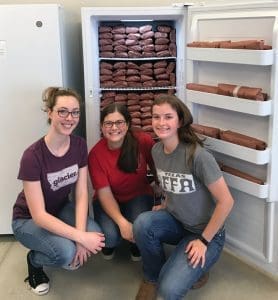Feeding the World Starts Here and Now
By Faith Baxter, Contributing Editor
It all started with a servant’s heart and an idea. The desire to help others using my knowledge of agriculture led to the creation of Center of the Plate, a non-profit organization dedicated to providing meat protein to help feed food-insecure families in my community of Dripping Springs, Texas. To date, we have been able to provide meat protein for more than 50,000 meals.
My work with Center of the Plate has focused my career goals and made me realize I want to bridge the educational gap between farmers and consumers by communicating the necessity of technology application in food production for improvements in production efficiency, resource sustainability and food safety. Most people are so far removed from agriculture and food production that they no longer understand the challenges farmers and ranchers face. I believe explaining the necessity of new technology advances to consumers and gaining their understanding is the key to decreasing food insecurity on a global level. 
I’m an agriculture advocate who grew up on a small cow-calf operation in east-central Kansas. There I saw the miracle of life, and also learned the need for responsibility, time-management, and putting the needs of others above my own. I also learned how critical it is to raise a healthy animal to one day enter the food chain.
My family moved to Texas in 2013, but I was able to stay connected to the agriculture community by joining 4-H and FFA. Center of the Plate, FFA and 4-H have provided me with countless leadership opportunities. I have embraced leadership roles in each organization and have realized that I can inspire others toward a common goal.
Center of the Plate came about because my family saw a need in our community. While Dripping Springs has other food assistance programs, none of these programs provides consistent access to meat protein. Meat protein provides us with the amino acids that our body can’t produce on its own and meat is the most efficient way to gain these amino acids. Center of the Plate has become a sustainable program based on the continued engagement of my 4-H and FFA peers along with strong community support.
Initially, I approached my 4-H club and FFA chapter to ask for donations of market steers and hogs for Center of the Plate. Funding was essential for purchasing freezers and paying for meat-processing costs; therefore, I worked to convince 11 local businesses to be program sponsors and secured funding from three community grant programs. Our local appliance store has donated six freezers and allowed us to purchase another at cost. My church built a dedicated mission space to house the 13 freezers and covers the freezer electrical costs.
The goal of Center of the Plate is to have a lasting impact on families in our community. We improved our breadth of influence by collaborating with others on community assistance efforts like Project Elf, a holiday initiative in which we distributed more than 550 pounds of meat to participating families. We also worked with the Texas Pork Producers as part of their community development efforts for the We Care initiative to secure a donation of 1,600 pounds of pre-cooked pork from Quick Fire Meats by Prairie Fresh, a division of Seaboard Foods. Local ranchers in our community also donated steers for processing to balance our offering of beef and pork.
Wednesday is my Center of the Plate day. I am at the church for 2-3 hours, helping pass out meat to families for their upcoming meals. We generally feed six to 10 families each week. Helping others by providing meat protein has opened my eyes to the importance of ensuring a steady food supply for a growing world population. I believe each of us in agriculture has a role to play in helping consumers understand the benefits of meat in a healthy diet. I hope the success of Center of the Plate sparks others to find a way to impact hunger in their community.






